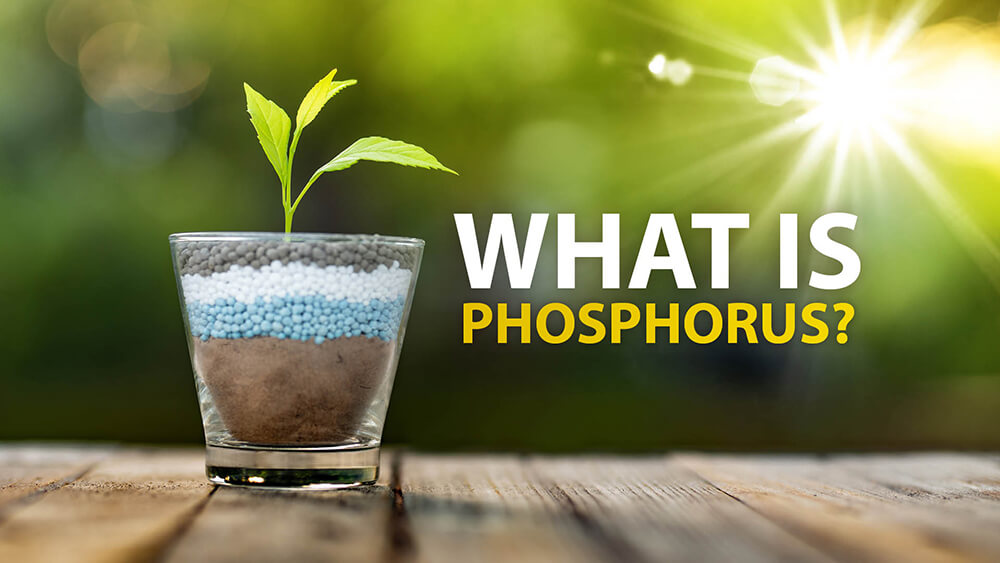Phosphorus: Putting the P in NPK
Phosphorus is a chemical element with the symbol P on the periodic table of elements. It is highly reactive and as a result is never found as a free element on earth – it’s always bonded with something else.
It’s needed – along with nitrogen – to form nucleic acid that makes up DNA and RNA. It forms an arm of the molecule ATP (adenosine triphosphate); a chemical compound that provides energy to drive a whole bunch of cellular processes. ATP is kind of like a unit of currency that cells use to get energy from each other.
Up, Down, All-Around; I hear that little nugget a lot and I hear P is Down – but down to what? What does that mean and what will phosphorus do for my plants?
Up, down and all-around can be a good guide to help remember what ratio of nitrogen, phosphorus and potassium you are looking for when purchasing a fertilizer for a particular growth stage of your plants. For example, plant starters and bloom fertilizers like 10-52-10 and 10-30-20 are targeted to those particular growth stages so going with those at the right times can be beneficial. Up, down and all-around really is just a good guide for getting generally the right ratios at the right time and can’t tell us a whole lot more than that.
That said; P is definitely down to promote early root growth. It’s just that it’s also up for reproduction. A plant needs a lot of phosphorus to set flowers, grow fruit and produce seeds.
Well okay then. But how can I really tell when I should use it? Will my plants tell me if they don’t have enough or if they have too much?
This many pronged question has a few prongs to each answer.
Without enough phosphorus a plant really struggles to meet its needs. There is super slow or no growth, poor root development and an overall failure to thrive. Older leaves may take on a dark green or purplish hue. Now, all of this could mean that you should add a phosphorus focused fertilizer product.
BUT it could also mean that there is phosphorus present – your plant just can’t get at it. When you apply a fertilizer product the phosphorus is super available – for a bit. But phosphorus is SUPER social so it starts mingling with the other molecules in the growing medium forming bonds all over the place. If the growing medium is on the acidic side – phosphorus will be particularly interested in the iron and magnesium, latch on to them and that’s that. This makes early symptoms of an over-load look a lot like iron and/or magnesium deficiencies.
If you suspect that there may be a phosphorus supply issue the first thing to do is check the pH of your growing medium – if it is below 5.5 or between 7.5 and 8.5 phosphorus uptake will be limited and it won’t matter how much you throw at your plant it will remain deficient until the pH is adjusted.
Can’t I just add phosphorus and not bother checking the pH?
Sure – it might work. BUT you might be adding nutrients that don’t go anywhere and just sit there and accumulate and start compounding problems. As the unused phosphorus builds up it will begin to cause lock-out of many other nutrients vital to your plant (like that iron and magnesium we talked about earlier). If this happens you’ll need to flush all this excess out of the root zone. To do so – run through 3 times the amount of water as you have medium. So – if you have a five gallon pot, you’ll need to put fifteen gallons of water through to successfully get everything out. There are products you can add – like Grotek’s Final Flush or Clear-Ex by Botanicare- that will grab onto the excess nutrients and pull them away from plant roots and medium. Using one of these can help get to the end result faster and with less water than just water alone.
If there is no way to check the pH and things seem dire – flush that water through and use a foliar feed to get some of the locked-up nutrients into the plant.
If I don’t use phosphorus or use too little, will my plants lack bloom?
The short answer here is yes they sure will – but as we talked about it’s really important to figure out if you are for sure lacking phosphorus before applying any. It’s also worth noting that when excess phosphorus from fertilizers– which is pretty water soluble – runs off into ground water or nearby water ways it can cause algae blooms and other environmental problems.
I hear phosphorus helps prevent disease in plants. Is this a fact?
It is indeed a fact. Except it does so by being some of the building blocks of molecules a plant needs to fight infection – such as RNA which is a messenger molecule that tells DNA what to do. When a plant gets invaded it will recognize the invader and send RNA molecules to tell DNA to start doing stuff to defend the plant and fight off the culprit.
As you can see phosphorus is an extremely important molecule for a whole bunch of plant processes all the way from the tips of roots to the petals of flowers to the DNA in seeds. Give your plant friends a little boost when they need it and you’ll have the best flowers on the block.
Did you enjoy this article? If so, go ahead and join our
NEWSLETTER COMMUNITY

Why join our newsletter community?
-
Latest tips and tricks on gardening
-
Monthly articles
-
scottsnursery.tv latest episodes
-
Gift card giveaways

JOIN TODAY! ENJOY YOUR MONTHLY BENEFITS OF OUR NEWSLETTER.



Recent Comments